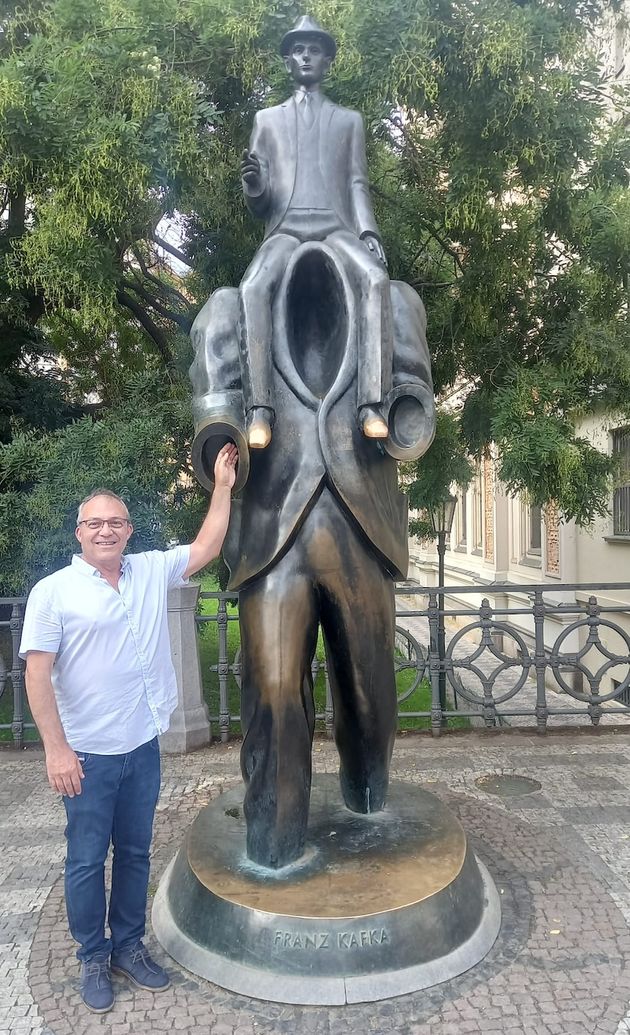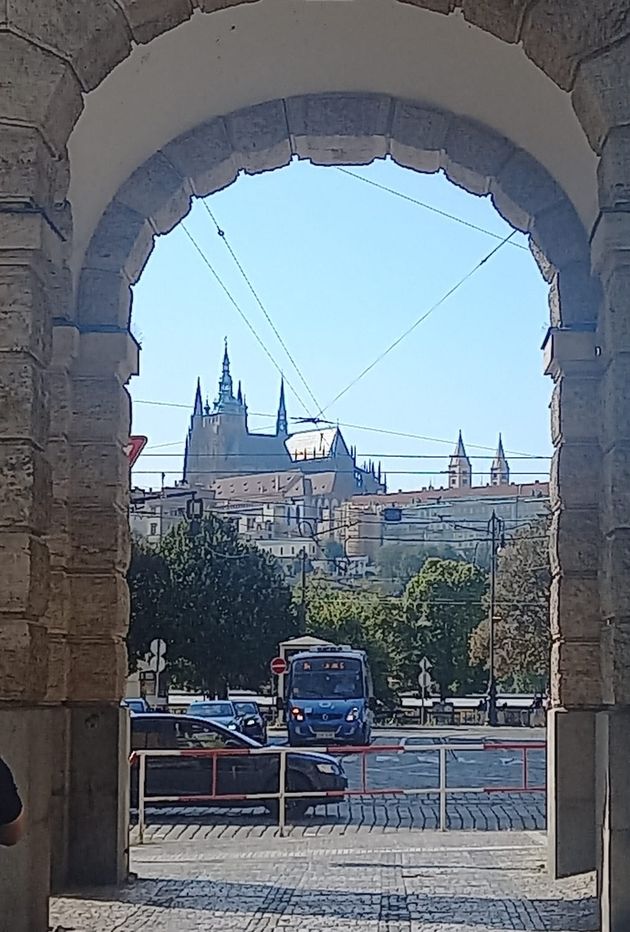The Czech writer shows us the reality of the modern human being, who, thrown into existence in a world he does not understand, lacks direction.

On the 100th anniversary of the death of the great Czech writer of German-Jewish origin, Frank Kafka, I had the opportunity to be in Prague, his birthplace and where he is buried.
When Kafka was born, Prague was the capital of the Kingdom of Bohemia, then part of the Austro-Hungarian Empire. To this day, the city is imbued with his memory, even though he was virtually unknown during his lifetime.
Kafka was born on July 3, 1883: “Being born in beautiful Prague, the most important capital of the Austro-Hungarian Empire after Vienna and Budapest, and into a middle-class bourgeois family, made him a privileged man”, says David A. Rosenthal.
The relationship with Hermann, his father, was not easy. Rather, Frank identified with his mother's family, the Löwys, wealthy merchants and industrialists, who also included artists and intellectuals.
The help of this German-Jewish family made Hermann an important textile merchant. Kafka studied law and received his doctorate in 1906. In those student days he became friends with Max Brod, who was to be responsible for ensuring that the literary work of Kafka, written in German, was not lost.
Brod apparently disobeyed Kafka's order to destroy his entire literary legacy. He edited and published his three most voluminous books: America (also known as The Missing), The Trial and The Castle.
Kafka worked in the insurance sector, but his great passion in life was literature. He was a voracious reader, but, above all, he loved to write.
He was in poor health throughout most of his life, and in order to recover he travelled incessantly across Europe, visiting Italy, France, Germany, Hungary and Switzerland.
The word that best defines Kafka's vision of the world, and which appears throughout his work, is, curiously enough, a derivative of his own name.
It is a Kafkaesque situation, something that is puzzling, that makes no sense, that is absurd. Kafkaesque is a mixture of surrealism and fantasy.
His work has influenced writers such as Albert Camus, J. P. Sartre, Jorge Luis Borges, Hannah Arendt, J. Maxwell Coetzee, Elias Canetti and, above all, Gabriel García Márquez.
Kafka could be a kind of precursor of the Colombian's magical realism. Kafka's literature masterfully shows the incomprehensibility of human life, the disorientation of existence.
For Judith Savloff, “the work of Kafka shows an unsettled world in which the protagonists search for meaning in their lives, desperately and in vain. For example, in the short story Report to an Academy, a chimpanzee believes that he could save himself from captivity by adapting to human evil and stupidity”.
Kafka died of tuberculosis in tragic circumstances, as he himself recounted in one of his best-known stories, An Hunger Artist. He died on June 3, 1924 in Kierling, near Vienna.
The monuments scattered throughout Prague, which pay tribute to his figure, highlight the confusion of the modern man. Kafka is a kind of prophet of our own times too. He was ahead of his time.
The poet and essayist Wystan Hugh Auden said: “If I had to name the author who comes nearest to bearing the same relation to our age as Dante, Shakespeare and Goethe bore to their own, Kafka would be the first writer who would come to mind”.
The statue at one end of the Jewish quarter, next to the Spanish Synagogue, the neighbourhood in which Kafka lived and wrote, reveals Kafka's insight into his own time and thus our own.
Jaroslav Róna's work, depicting a hollow human being, vividly underlines the existential emptiness that Kafka perceived within the human heart. The statue refers to some of his best-known stories.

First of all, in Description of a struggle, where, with the background of the city of Prague, in which Kafka places many of his characters, he skilfully depicts the confusion with which human beings live in this world, even in the most familiar and everyday places and circumstances.
This is the scene of the Kafkaesque tale to which this work alludes:
“In an instant and with unusual deftness I had jumped on the shoulders of my acquaintance and by stabbing my fists into his back brought him to a light canter. When still he unwillingly stamped his feet a little and at times even stood still, I dug my boots into his stomach repeatedly in order to make him brisker. I succeeded and with good speed we came further and further into the inner precinct of a great but yet unfinished region, in which evening had descended”.
But the statue also appeals to the famous beginning of The Metamorphosis, undoubtedly the Czech author's most famous short story: “As Gregor Samsa awoke one morning from uneasy dreams he found himself transformed in his bed into a gigantic insect”.
Nabokov said of this insect that it was, quite simply, a large beetle, a strange being in a hostile world, a parable of how we feel in this world.
Another fascinating creation that remembers him in Prague is the so-called bust of Kafka, an immense rotating head, the work of David Cerny, which stands majestically, very close to Kafka's workplace.

[photo_footer]Bust of Kafka, by David Cerny / José Moreno [/photo_footer]
This work evokes the lack of identity of the human being who, without roots, constantly changes his appearance. The shining head is unstable, just as our lives are unstable.
In a letter to his younger sister Ottla, Kafka remarked: “I do not write as I speak, I do not speak as I think, I do not think as I should think, and so on into the deepest darkness”. By the way, both Ottla and her two other sisters, Elli, Valli, died during the Nazi Holocaust.
Ultimately, Kafka's literature embodies J.H. Bavinck's statement: “Of all the beings in this world the most enigmatic, inconstant and indeterminate is man”.
Peter Watson points out that “the aim of Kafka's stories is to convey to the reader the unbalanced, uneasy, bewildering feeling that is the essence of the modern condition”.
Kafka, then, shows us in a harsh and sometimes even comical, but brutal way, the reality of the modern human being, who, thrown into existence in a world he does not accept, lacks direction and orientation.
His powerful metaphors continue to impress us deeply as a faithful image of what we are.
The novel The Trial points to the lack of understanding of what is happening to us in this universe of ours, the absence of understanding that Joseph K. experiences when he is arrested and does not know the reasons why. Kafka expresses here that modern bewilderment in the face of the often Kafkaesque circumstances that happen to us.
And this is not all we can find in Kafka.
Another of his books entitled The Castle, considered his greatest work, and written at the end of his life, shows a character called K. (does he allude to himself, we cannot be sure), a surveyor who is summoned to an enigmatic castle (is Kafka recreating the one that crowns the city of Prague?)
Although nothing seems to have any clear purpose, K. earnestly seeks to belong “to the great castle”, as Kafka calls it in the novel. There is opposition, but K. will not give up, despite the obstacles he encounters.
The book is extremely complex, and admits many interpretations, but K.'s fierce aspiration for the castle suggests that incessant demand for meaning that characterises the human being.
That is precisely one of Kafka's contributions to world literature, that of characters who are disoriented but not satisfied with their situation. That thirst for meaning present in every human being points to God himself.

[photo_footer]The castle that may have inspired Kafka's work / José Moreno [/photo_footer]
It is God who has put this longing for Him in our hearts. As the psalmist expresses it: “As the hart panteth for the water brooks, so my soul panteth for thee, O God. My soul thirsts for God, for the living God”, Psalm 42.1,2.
Or as Augustine of Hippo said: “You have made us for yourself, O Lord, and our heart is restless until it rests in you”.
The ups and downs and vicissitudes that befall us in the course of our often frustrating existence point us to Him, for only God can satisfy the human being integrally.
God summons us to come into His presence and He does so through His own Word. This should come as no surprise, for it is the Scriptures that unravel and explain the keys to life.
That was the experience of the psalmist “Your word is a lamp to my feet and a light to my path”, Psalm 119:105.
Scripture also introduces us to our Lord Jesus Christ, the One who gives us a new identity through faith in Him. He alone can fulfil every human longing for direction. And this He does by His very presence.
His promise is still available to all: “Behold, I stand at the door and knock; if anyone hears my voice and opens the door, I will come in to him and dine with him, and he with me”, Revelation 3.20.
José Moreno Berrocal, chair of the Theology Group of the Spanish Evangelical Alliance, author, and pastor of an evangelical church in Alcázar de San Juan (Spain).

Las opiniones vertidas por nuestros colaboradores se realizan a nivel personal, pudiendo coincidir o no con la postura de la dirección de Protestante Digital.
Si quieres comentar o